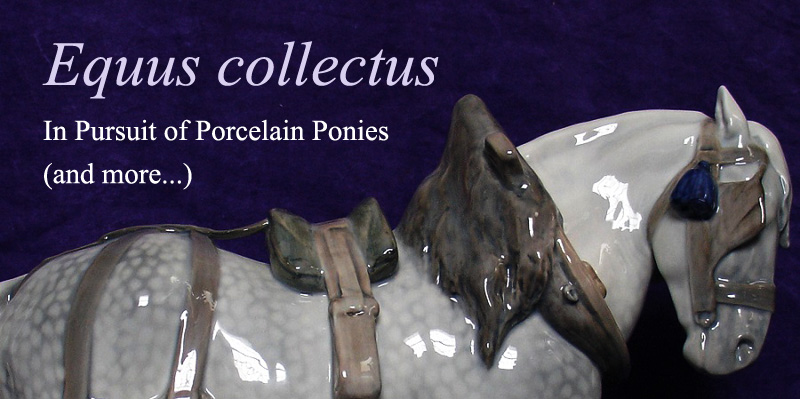One of my favorite sculptors of "Old Euro" horse figurines is Professor Theodor Karner (January 10, 1884 - September 6, 1966) of Germany. Prof. Karner worked for such prestigious porcelain firms as Nymphenburg, Rosenthal, Eschenbach, as well as for Allach (which is somewhat infamous due to its connection to the Third Reich).
A very skilled artist, Prof. Karner sculpted a wide variety of animal and human figurines. His horses, in particular, are typified by a very refined, elegant look, sometimes a bit stylized, but always exceptionally modeled with great attention to musculature. The faces of his horses are also wonderfully expressive. Delicately-rendered ears and dynamic, finely-detailed manes and tails are other hallmarks of Prof. Karner's equine creations.
Given his high calibre of artistry, Prof. Karner's works are highly sought after by porcelain collectors. Some of his horse figures are very rare and difficult to acquire, due to a combination of age, fragility, and limited production run. Other examples, however, were produced for many years, and can be easily sourced. This is not to say that the more common pieces are any less appealing than their more elusive counterparts, however.
To illustrate this point, today's post will be dedicated to a horse Prof. Karner sculpted for Rosenthal in 1934. Model #1528 depicts a rather snooty warmblood-type foal standing in a semi-parked-out pose on a grassy base. Anyone who collects Rosenthal horses will be familiar with #1528, as this attractive foal was produced for decades.
I've had this lovely decorated example of #1528 for a few years, which I acquired from a fellow collector. (Sharp-eyed readers might also recognize him as my blog avatar!) #1528 is comparable in size to a Breyer Traditional scale foal, standing 7 1/2 inches high. The colored glaze brings out the subtle, shaggy textures of a foal's coat that Prof. Karner meticulously reproduced in the original sculpture.
I am not exaggerating when I say that #1528 is probably my favorite equine sculpture by Prof. Karner. To me, this foal is the most naturalistic of the great artist's horses, while still exhibiting the sculptural presence that his work is known for.
But wait, there's more!
I recently went antiquing, returning to a small town with a few nice shops that I hadn't been to in several years. I had gone through two antique malls and had found no horses, and was almost through the third and final mall (and despairing of any hope of finding clinkies) when I glanced in a glass display case next to the checkout counter. There, lurking in the back of the cabinet, was a very familiar-looking foal, a white horse-shaped spectre amidst a sea of ceramic nick-knacks and other small collectibles.
I admit, I actually hesitated over whether I should buy him because
The fact that the shop only had white butcher paper to wrap purchases simply reinforced my rule of thumb when antiquing - always, always bring bubble wrap and a box (or bin) in the car, which fortunately I had. Even so, I was relieved to see that he made the drive back safe and sound.
Upon conversing with some collector friends who also love Old Euro figures, I learned that #1528 is somewhat unusual compared to other Rosenthal horses sculpted by Karner in that the decorated version, generally a muted "baby" bay or chestnut coloring, is far more easily found than the undecorated version with clear glaze over white bisque. (Thus were banished any thoughts about having him custom glazed!)
I was eager to compare him to his colored counterpart. Prepare to be inundated with side-by-side photographs!
One noticeable difference between the two was that the white foal's head was slightly more turned than the colored one. The variation is significant enough that I wondered if, since the white foal predates the colored foal, it was an intentional modification to the mold for easier casting. Without a third example of #1528 to compare to in person, however, such thoughts are purely speculative at this point.
It was also instructive to compare underneath their bases:
 |
| White #1528 Foal with original label |
 |
| Colored #1528 Foal |
Based on the Rosenthal backstamps, the white #1528 foal was produced early on, between 1936-1944 (more likely in the 1930s than 1940s), while the colored #1528 foal was produced around 1960. It is interesting to see how the mold number, which is incised below Prof. Karner's signature on the white foal, appears at a different spot on the colored foal. Also, the backstamp is in a different location on both examples. Finally, the colored foal has a center supporting strip of porcelain under the base that the older white foal lacks.
Well, that about does it for this post. I hope to have a more substantive article next time. I've been kicking around an idea for a while but haven't quite found the right tone. Crossing my fingers that inspiration will strike and get the ball rolling so that you'll have something to read from me before December 2018!
Until then, Happy New Year to all!
References:
Kathleen Williams' Karner Page: http://www.horsyme.com/Karnerpage.html
Model Horse Gallery Rosenthal Page: http://www.modelhorsegallery.info/R/R-companies/MHCs_Rosenthal.html
Wikipedia Allach Porcelain Page: https://en.wikipedia.org/wiki/Allach_(porcelain)
Rosenthal Marks Dating Reference Site: http://collectrosenthal.com/markingsdate.html
Special thanks to Diane Gutzwiler.













